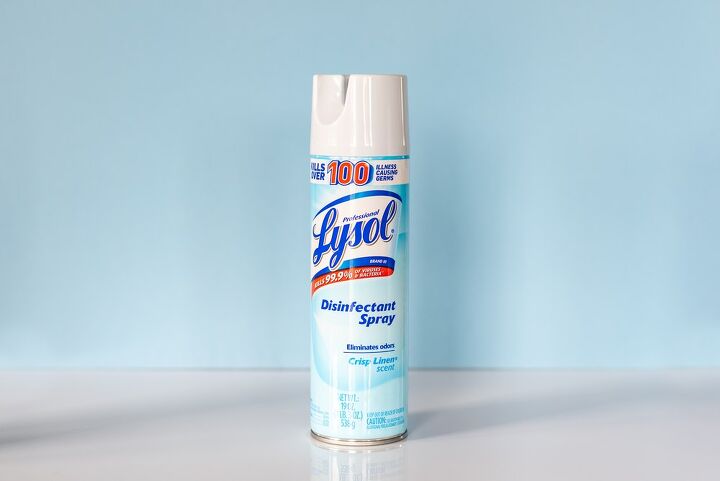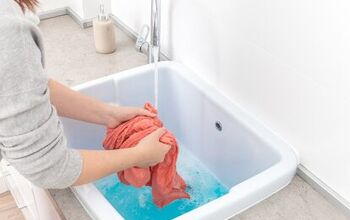Does Lysol Kill Dust Mites?

Having a dusty home is not only unappealing, but it can also negatively impact your indoor air quality and lead to a wide range of health issues. If you’ve ever had persistent allergies or continuously deal with asthma symptoms while in your own home, there’s a good chance dust mites are to blame. Unfortunately, dust mites are incredibly common, which makes it very important to know how to get rid of them.
Yes, Lysol spray can kill dust mites. The ethanol and ammonium-based compounds in Lysol disinfectant spray are toxic to dust mites. Immersing dust mite-infested furniture and fabrics in Lysol spray will kill them almost immediately. There are also natural alternatives to killing dust mites. Make sure you clean and rid your home of the allergens themselves.
In this article, we’re going to go over everything you need to know about how to kill dust mites with Lysol spray. We’re also going to talk about what else you can do to eliminate these pests as well as how to identify and deal with all the issues they bring with them. Let’s get started.
Do You Need Pest Control Services?
Get free, zero-commitment quotes from pro contractors near you.

What are Dust Mites?
Before we talk about how to kill dust mites, it will be helpful to know what they really are. Dust mites are microscopic pests that populate in dusty areas where they can feed on dead skin cells. They are most commonly found in carpeting, bedding, mattresses, pillows, furniture, and stuffed animals.
Despite the similarity in name, dust mites are not the same as termites. They are also not parasitic, meaning they will not bite or sting you. They do, however, generate some of the most common allergens through their fecal pellets and body fragments.
It sounds gross, but dust mites are everywhere. In fact, approximately four out of five homes across the country have dust mites in at least one room. They cause allergies that range from mild to severe, including:
- Runny Noise
- Watering Eyes
- Sneezing
- Chronic Coughs
- Congestion and Pressure
- Severe Asthma Attacks
What is Really in Lysol Spray?
Next, we should break down what is in Lysol spray. Odds are, you’ve used this all-purpose cleaner for years as a disinfectant, cleaner, and air freshener. That said, do you really know what it is? Simply out, Lysol is a mixture of soft soap and cresols. Its active ingredients include…
- Alkyl dimethyl
- Benzyl ammonium saccharinate
- Ethanol alcohol 40
…Plus, additional antiseptic agents to sanitize and remove odors.
Signs You Have Dust Mites in Your Home
Dust mites are invisible to the naked eye, so they cannot be visually spotted. Thus, you’ll have to pay attention to any symptoms you may have. Allergic reactions are the best ways to identify a possible dust mite problem. These symptoms might include:
- Wheezing or trouble breathing
- Red, itchy skin rashes
- Runny nose or nasal congestion
- Constant sneezing
- Itchy throat
A note: older homes with mildew and mold issues are more susceptible to dust mites. Homes with a high level of humidity are also more susceptible. Dust mites don’t usually thrive in dry, hot environments. In addition, homes with lots of carpeting or upholstered furniture are more at risk.
Killing Dust Mites with Lysol Spray
Lysol spray may not be the most natural method of killing dust mites, but it is effective. Dust mites cannot simply be vacuumed up or washed away. Exterminating them requires chemicals, or high levels of heat. Lysol spray is a good choice because it’s very affordable and found in most US stores.
Before applying the Lysol spray, wash all your bedding or curtains in hot water. Steam cleaning the carpets before spraying when possible is also a good idea. These measures will kill some of the dust mites, and bring others out from hiding.
Now you can apply the Lysol disinfectant spray. Follow the directions on the can carefully.
- Hold the can 6” to 8” from the surface.
- Spray 3 to 4 seconds until the surface is completely covered with mist.
- Leave the surface wet for at least 3 minutes, then allow to air dry.
- Repeat washing the bedding or curtains in hot water, or steam vacuuming carpets after Lysol dries.
Killing Dust Mites in Your Bedroom
Not all ingredients in Lysol disinfectant spray are organic, which means you may not want to use it everywhere throughout your home. This includes in the bedroom, which is coincidentally where you can find the largest populations of dust mites.
That said, you can still wipe down surfaces like the bed frame and dressers in your bedroom with Lysol wipes. You can even use Lysol on wooden surfaces, though you probably should dilute it with water with older wood.
Alternatives to Lysol Spray
As far as sprays to get rid of dust mites go, there are a couple of alternatives to Lysol, so you’re not spraying chemicals over your bedding. These include organic dust mite sprays and homemade concoctions, too. As far as organic store products go, some of the best include:
- Allergy Asthma Clean Allergen Spray
- All-Natural Eucoclean 3-in-1 Bed Bug, Flea, and Dust Mite Killer
- Easy Air Organic Allergy Relief Spray
- Eradicator Bed Bug and Dust Mite Spray
- Natural and Organic Dust Mite Spray
…and more!
However, you can also make your own organic spray that you can use daily without any issues. The best part is it just requires three ingredients:
- 30 drops of essential oils. The best oil to use are eucalyptus essential oils because dust mites hate eucalyptus. Clove, peppermint, lavender, and tea tree oil are also effective. Be sure to use a dark glass bottle to better preserve the oils, too.
- 1 ½ ounces of vodka. The alcohol in this mixture will break up the oils and make sure it is evenly distributed throughout the mixture since oil and water don’t naturally mix. It also will sterilize and kill bacteria and pathogens on any surfaces you spray it on.
- 1 ½ ounces of water. The water in this mixture quite simply helps dilute the entire mixture, so it’s not too potent.
Natural Ways to Kill Dust Mites
Are you looking for another way to kill dust mites? Lysol disinfectant spray is effective, but it contains harsh chemicals. Here are natural alternatives to exterminate these pests.
- Diatomaceous earth. This is a naturally-occurring silica rock derived from algae. This fine white powder dehydrates dust mites to death by drying out their exoskeletons. Sprinkle it on any fabric surface, then vacuum it up.
- Essential oils. Dust mites are repelled by essential oils. Clove, eucalyptus, lavender, peppermint, and rosemary are the most effective. Combine a few drops in a spray bottle of water, and spray the mixture onto fabric surfaces.
- Washing fabrics in hot water. Dust mites can’t survive temperatures above 130 F. Toss your bedding or other fabrics into the washing machine on its hot water setting. This will kill dust mites and remove the allergens.
Reducing the Presence of Dust Mites Over Time with Lysol (and Some Other Things)
While you can kill the majority of dust mites by simply spraying them with Lysol or other sprays, you still need to eradicate the allergens they leave behind. That means getting rid of dust mite waste, too.
After you clean the area, vacuum everything to remove the dead dust mites and any waste they left behind. The best way to do this is with a HEPA (High Efficiency Particulate Arrestance) vacuum.
The most important thing to remember is not to wait for dust mites to become an issue. The best way to keep dust mites out of your home is to clean regularly even when they aren’t present. This includes dusting, vacuuming, and changing HVAC air filters.
Another way to keep dust mites out is to lower the humidity levels in your home by using air purifiers and humidifiers. You can also cover your bedding with dust mite covers for additional protection.
Signs of Dust Mites in Your Home
There are many different causes for dust mites, including high humidity and high levels of dust. If you’re not sure if you have dust mites or not, there are a few things you can keep an eye on. Common symptoms from dust mite allergies include:
- Fatigue and Metal Fogginess
- Eczema and Skin Rashes
- Itchiness
- Nasal Congestion
- Coughing and Wheezing
- Runny and Itchy Nose
- Constant Sneezing
Related Questions
Are dust mites harmful to humans?
Dust mites usually will not bite a person, and if they do, it won’t cause you any serious pain. They hardly ever find themselves crawling on people, though they can get on your clothes. That said, they are indeed harmful since they bring with them high levels of allergens that can negatively impact your health over time.
How long do dust mites live?
Dust mites don’t have a terribly long lifespan, but they do reproduce rather quickly. Most dust mites will live for between 65 and 100 days and the average female will usually lay 60 to 100 eggs.
Does Febreze kill dust mites?
Recent studies have shown that Febreze Allergen Reducer can cut down the amount of allergens produced by dust mites by approximately 75%. That said, it isn’t the best product to kill the dust mite itself.
Do You Need Pest Control Services?
Get free, zero-commitment quotes from pro contractors near you.

So, Should Lysol be Your Weapon of Choice Against Dust Mites?
If you are looking for an easy way to rid your home of dust mites, Lysol disinfectant spray is a great tool to have on your side. However, it should not be the only tool in your toolbox. Lysol spray can kill dust mites on contact, but you still have to get rid of their bodies and any waste left behind.
For this step, you’ll need a vacuum—preferably a HEPA vacuum—so you can completely clear your home from all harmful allergens. In lieu of Lysol spray, you can use organic alternatives for your bedding to ensure your health, safety, and comfortability while you sleep going forward.

I am a copywriter and editor based in the Las Vegas area with nearly a decade of experience under my belt writing landing pages, cost guides, blog posts, newsletters, case studies, and social media content. I have a degree in Strategic Communication and experience working in both the account and creative spheres. My goal is to always be discovering new interests and bettering myself as a writer and editor along the way.
More by Kerry Souder



























